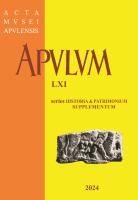QUELQUES CONSIDÉRATIONS SUR LE CATÉCHISME PERDU ET RETROUVÉ DE GEORGES BRANKOVIĆ
Some Considerations on the Lost and Found Catechism of George Branković
Author(s): Levente NagySubject(s): History, Literary Texts, Cultural history, Romanian Literature, 17th Century
Published by: Muzeul National al Unirii Alba Iulia
Keywords: George Brancovici; orthodox catechism; theological dispute; Reform and Romanians; New Testament of Bălgrad (1648);
Summary/Abstract: George Branković (Gheorghe Brancovici, Đorđe Branković, 1645-1711) was the brother of the Greek Orthodox bishop of Transylvania, Sava Brancovici (1615-1683). Initially, he was Apafi’s envoy and interpreter in Constantinople. Later, he became secretary to the Prince of Wallachia, Şerban Cantacuzino (reigned 1678-1688). Emperor Leopold I granted Branković the title of baron in 1683 and count in 1688. In 1690, imperial general Ludwig Wilhelm von Baden arrested him because he believed that Branković was inciting the Serbs against Vienna. After his arrest, Branković remained in prison for the rest of his life: he was imprisoned in Vienna until 1703 and then in Egger in Bohemia until 1711. During his imprisonment, he even composed an anti-Catholic and anti-Calvinist catechism. It was Emil Turdeanu who, during research carried out in 1936 and 1937 at the Library of the Royal Serbian Academy in Belgrade, discovered three religious works by George Branković. At the time, these three texts by Branković were in two different manuscripts. One, designated by Turdeanu as A, carried the number 168/8. The contents of this manuscript were as follows: 1. Book of holy prayers; title: Carte aciasta a sfântelor rugăciuni. 2. Catechism, in questions and answers, including 44 chapters (untitled) 3. Advice for true travelers; title: Cătră adevărați călători, comprising thirteen paragraphs. The other manuscript named by Turdeanu B, bore the number 236. According to him this manuscript presents the same texts as manuscript A except that it omits from the end of the Book of Prayers a brief biographical note, deletes the incomplete text from the end of manuscript A, that is to say Advice for true travelers. On the basis of two short autobiographical notes contained in the text of manuscript A, Turdeanu was able to establish precisely that the said manuscript was completed in October 1690. Manuscript B being a copy of manuscript A was written later and must have been made by one of those men with whom Branković came into contact during his stay in prison in Vienna: a certain Jovan Aleksijević, dvornik pisar with the despot, or Jovan Lipovskí, a relative of Branković, who accompanied the prisoner in his exile to Egger in Bohemia, and who collected the last confessions. It is thanks to him that, after long efforts with the Austrian authorities, the literary heritage of Georges Branković was returned to Serbian circles. Shortly after the publication of Turdeanu’s article on the discovery of Branković’s religious works, World War II broke out. Thus, Turdeanu no longer had the opportunity to make a more in-depth study of this subject, nor to edit these three works of Branković. Especially since even Turdeanu believed that during the bombing of Belgrade in April 1940 by the German air force, the two manuscripts containing Branković’s three texts had been destroyed. Fortunately, this is not the case, because during the bombing only manuscript 168/8 was destroyed. The other manuscript bearing the number 236 was preserved and can still be found today in the archives of the Library of the Serbian Academy (Српска Akadемија наука и уметности, SANU) under the same symbol. This manuscript is not autograph and contains only the prayer book and the catechism. Relevant literature has so far only registered the existence of the catechism, but the text has not yet received proper scholarly treatment. In the catechism, Branković defined Eastern Orthodoxy in opposition to Transylvanian Calvinism and the pressure of Catholic cultural colonisation emanating from the Viennese court. Branković’s work is a particularly important piece of cultural heritage because it deals with topics that are not usually discussed in contemporary catechisms: witchcraft, oath-breaking, popular religiosity, etc. In my study, I would like to make a brief comparison between some chapters of Branković’s catechism and between the other catechisms of the time (Ștefan Fogarasi, Varlaam, Cyrille Loukaris) and between the prefaces written to the different books of the New Testament text of the New Testament of Bălgrad (1648). I will treat first of all the chapters in which faith, good works and fasting are discussed.
Journal: Apulum
- Issue Year: 61/2024
- Issue No: 1
- Page Range: 33-48
- Page Count: 16
- Language: French
- Content File-PDF

